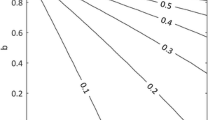Abstract
The residence time of the water masses in the Westerschelde estuary was determined using a simple compartment-model that simulates the advective-diffusive transport of a conservative dissolved substance (chlorinity). The residence time of a water parcel in the upstream part of the estuary (i.e. the time needed for this water parcel to leave the estuary) varied from about 50 days in winter to about 70 days in summer. The most seaward compartment had residence times of about 10-15 days.
Dispersive coefficients that are fixed in time were able to reproduce the observed salinity distributions very well in the Westerschelde. They were obtained by calibration on observed chlorinities. It is argued that the apparent relationship of dispersive coefficients with freshwater flow, which is observed in certain studies, could (partly) reflect the deviation from steady state conditions which are required assumptions to calculate these dispersive coefficients directly from salinity profiles.
Similar content being viewed by others
References
de Hoop, B. J., P M. J. Herman, H. Scholten & K. Soetaert, 1993. SENECA 2.0. A Simulation ENvironment for ECological Application. Manual.
Heip, C., 1988. Biota and abiotic environment in the Westerschelde estuary. Hydrobiol. Bull. 22: 31–34.
Helder, W. & P. Ruardij, 1982. A one-dimensional mixing and flushing model of the Ems-Dollard estuary: calculation of time scales at different river discharges. Net. J. Sea Res. 15: 293–312.
Klepper, O., H. Scholten & J. P. G. Van de Kamer, 1991. Prediction uncertainty in an ecological model of the Oosterscheldt estuary. J. forecasting 10: 191–209.
Loder, T. C. & R. P. Reichard, 1981. The dynamics of conservative mixing in estuaries. Estuaries 41: 64–69.
Miller, R. L. & B. F. McPherson, 1991. Estimating estuarine flushing and residence times in Charlotte Harbor, Florida, via salt balance in a box model. Limnol. Oceanogr. 36: 602–612.
O'Kane, J. P., 1980. Estuarine water-quality manaqement. Pitman, Boston.
Radford, P. J., 1978. Some aspects of an estuarine ecosystem model — GEMBASE. In Jorgensen (ed.), State of the art in ecological modelling, Pergamon Press, Oxford, 301–322.
Ruardij, P. & J. W. Baretta, 1988. The construction of the transport model. In Baretta & Ruardij (eds), Tidal flat estuaries. Simulation and analysis of the Ems estuary. Springer-Verlag, Berlin: 65–76.
SAWES, 1992. Waterkwaliteitsmodel Westerschelde. WL-rapport T257.
Soetaert, K. & P. M. J. Herman, 1995a. Nitrogen dynamics in the Westerschelde estuary (SW Netherlands) estimated by means of the ecosystem model MOSES. Hydrobiologia 311 (Dev. Hydrobiol. 110): 225–246.
Soetaert, K. & P. M. J. Herman, 1995b. Carbon flows in the Westerschelde estuary (The Netherlands) evaluated by means of an ecosystem model (MOSES). Hydrobiologia 311 (Dev. Hydrobiol. 110): 247–266.
Takeoka, H., 1984. Fundamental concepts of exchange and transport time scales in a coastal sea. Cont. Shelf Res. 3: 311–326.
Thomann, R. V. & J. A. Mueller, 1987. Principles of surface water quality modelling and control. New York, Harper & Row.
Uncles, R. J. & P. J. Radford, 1980. Seasonal and spring-neap tidal dependence of axial dispersion coefficients in the Severn — a wide, vertically mixed estuary. J. Fluid Mech. 98: 703–726.
Van Eck, G. Th. M. & N. M. de Rooij, 1990. Development of a water quality and bio-accumulation model for the Scheldt estuary. In W. Michaelis (ed.), Coastal and Estuarine Studies. Springer Verlag. Berlin, Heidelberg, etc. 95–104.
Wollast, R., 1983. Interactions in estuaries and coastal waters. In Bolin, B. & R. B. Cook (eds), The major biogeochemial cycles and their interactions. Scope.
Zimmerman, J. T. F., 1976. Mixing and flushing of tidal embayments in the western Dutch Wadden Sea. Part I.: distribution of salinity and calculation of characteristic mixing time scales. Neth. J. Sea Res. 10: 149–191.
Author information
Authors and Affiliations
Rights and permissions
About this article
Cite this article
Soetaert, K., Herman, P.M.J. Estimating estuarine residence times in the Westerschelde (The Netherlands) using a box model with fixed dispersion coefficients. Hydrobiologia 311, 215–224 (1995). https://doi.org/10.1007/BF00008582
Issue Date:
DOI: https://doi.org/10.1007/BF00008582




